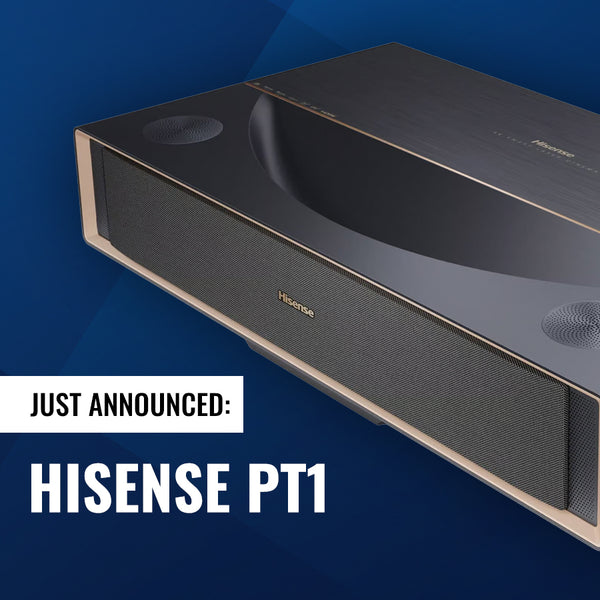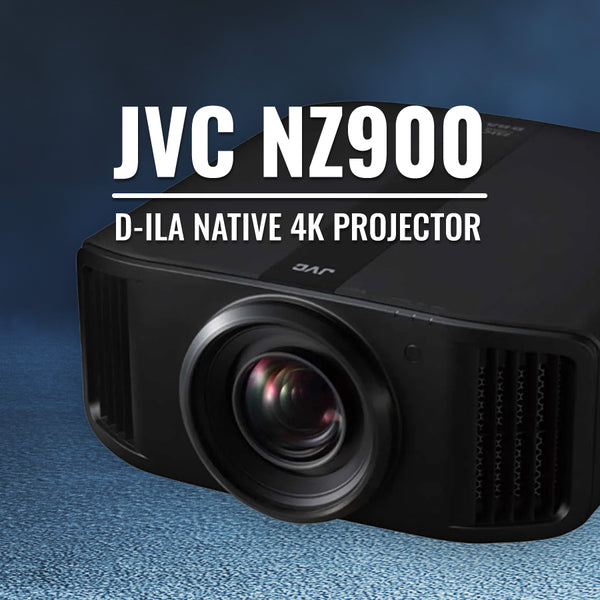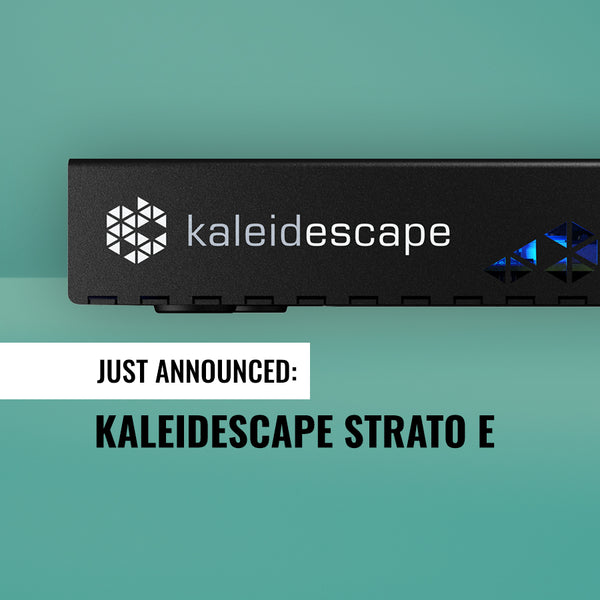The Complete Guide To Outdoor Projectors and Screens
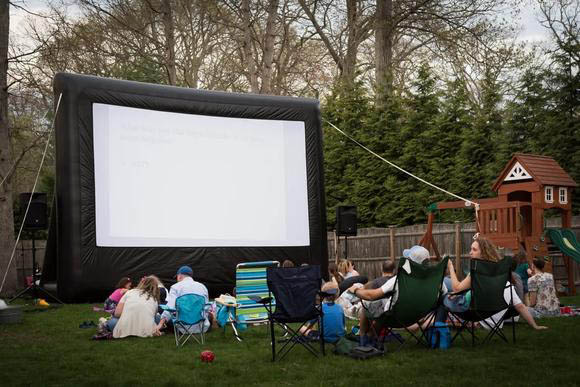
Everything You Need To Know About Outdoor Projector Screens and Projectors For Your Backyard
Modern families that have made a tradition out of hosting their own family movie nights are always on the lookout for ways to keep the experience fresh and exciting for everyone. Many are even choosing to take their backyards to the next level by transforming them into charming exterior home theaters with an outdoor projector screen and backyard projector to match – the perfect way to enjoy movie night and make the most of the balmy summer days to come.
If you want to build your own backyard home theater with an outdoor movie screen and projector setup, now is the time to get your pre-summer project started because this is the guide for you!
It's important to understand that your viewing experience will only be as good as the equipment you select. That’s why we wrote this guide to backyard projectors and screens.
We’ll cover what to look for in a backyard projector and outdoor projector screen to give you the best backyard movie watching experience possible.
So without further ado, here's how to make sure your outdoor home theater is everything you need it to be and more!
How Does Outdoor Movie Watching Differ from Indoor Viewing?
Some people looking to create a stunning outdoor theater already have projectors and projection screens that work perfectly well indoors. They simply assume that same equipment will perform just as well outdoors, only to be sorely disappointed by an experience that's not even close to drive-in quality.
When you watch a projected movie indoors, it's generally (and ideally) in a room that's perfectly dark and controlled. This allows for the type of viewing experience you'd expect in a theater environment; however, it's never perfectly dark outside, even after sunset.
Your out-of-the-house projector will be competing with ambient light from passing headlights, house lights, street lamps, your fire pit, your barbecue grill, the moon, and even the stars on a clear night. You'll need to select a projector and screen capable of offsetting the interference caused by these light sources.
The outdoor projector and screen combo
When it comes to visuals for movie watching outdoors you can have a huge backyard cinema screen but if it’s not paired with the right projector, you’re going to have a subpar movie watching experience.
When pairing an outdoor projector and screen, it’s all about the System Foot-Lamberts. The system foot-lamberts is the way to measure if your backyard projector and screen are working together as a projection system to provide enough brightness to give you an optimal viewing experience.
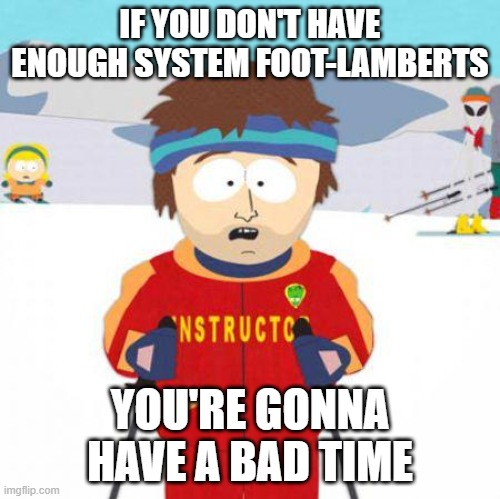
The Society of Motion Picture and Television Engineers (SMPTE) recommends 16 foot-lamberts for a darkened movie theater for a professional cinematic viewing experience.
When it comes to watching movies outside it’s much more difficult to control the light levels. You’ll need to deal with light coming from the moon, stars, streetlights, neighbors lights and general light pollution.
For an outdoor home cinema build you’ll likely need to have at least 40ftL for spaces with moderate levels and of ambient light and 60ftL for environments with high levels of ambient light.
If you want to start your outdoor movies at dusk you’ll need at least 60ftL. For daytime viewing you’ll need to have even more luminance.
If you don’t have enough foot lamberts, your projected image will look dull and washed out with poor contrast. Not the way you want to watch a film in your backyard.
You can use our foot lamberts calculator to determine if you’ll have enough brightness from your backyard projector and screen combo.
Sunshine, Shade and Projection
If you plan to watch a movie before or during sunset your projector and screen in the great outdoors will be competing with brightness from the sun. You'll need a larger number of foot-lamberts for an outdoor projector and screen combo that has sun at all times of day, less for a partially shaded projector screen, and even less if you're able to fully shade the display surface.
Outdoor Projector Screens
The first half of a backyard projection system is the outdoor projector screen.
These outside screens come in all different shapes and sizes. Some can be hung up, some fold up, some come with stands, and some are even inflatable.
There are a few features and attributes that will help you pick the best outdoor projector screen for your backyard theater setup.
In this guide we’ll just cover the attributes that affect your outdoor viewing experience. You can read our complete guide to projector screens here.
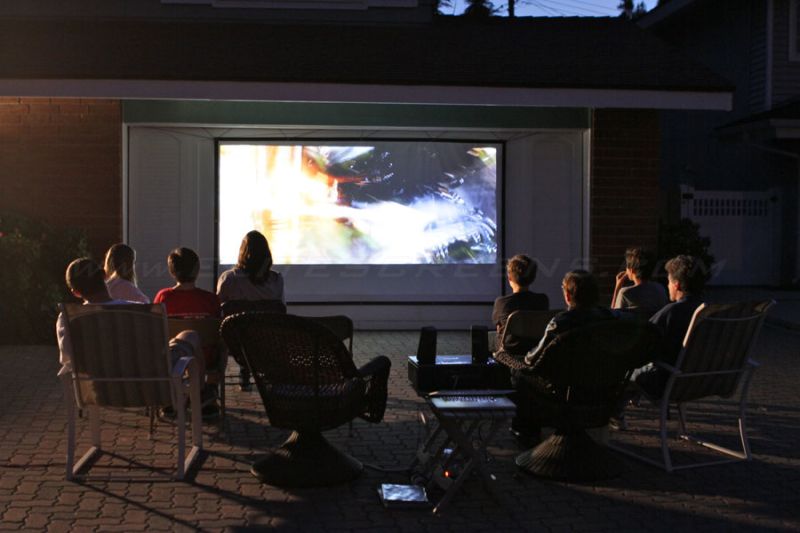
Qualities To Look For In An outdoor Projector Screen
When you buy an outdoor projector screen there are a few qualities you need to consider that you wouldn’t with an indoor display.
Stability
Make sure when you get your outdoor projector screen setup that it stays up. Wind can quickly ruin an evening's events, which makes stability paramount.
Exterior cinema screens are made to be both large and lightweight. Because of this, they can easily act like a sail on a boat catching the wind, making them easy to blow over. The larger the screen, the more surface area for the wind to catch, so the more likely it is to fall over.
Especially for large outdoor movie screens, you’ll want to make sure you have pegs, stakes, and ropes to anchor the screen to the ground. Consider adding extra weight and positioning the screen strategically away from the wind, if possible.
Tensioning
Getting a tensioned projector screen is especially important for movie screens outside. If you don’t use a tensioned projection surface you’ll be projecting on a surface that isn’t smooth, you’ll see every wrinkle and fold line.
On top of that, if you don’t get a tensioned outdoor projector screen you’ll be watching movies with tremendous annoyance as every little gust of wind will cause the surface to ripple, taking you out of the immersive film watching experience.
Projector Screen Size
When it comes to projector screen size for an open air cinema, no one has ever said, “Man, I wish I bought a smaller screen.” We always recommend getting the biggest movie screen your budget and space limitations would allow for.
A 20 foot inflatable screen would be awesome but it isn’t ideal for small outdoor spaces. Not to mention you’d need a significantly bright projector to pair with it.
Measure your backyard and figure out what the maximum size screen you can fit would be. You’ll also want to measure the approximate location of the viewer. The way to measure this is that for every 12 inches of screen width you want to be sitting 10 inches from the screen. By figuring out where you’ll be sitting and the maximum space your screen can fit you’ll be able to calculate the recommended projector screen size for outdoor viewing.
Here are some common outdoor screen sizes and an approximation for how many audience members they can accommodate.

Types of Outdoor Projector Screens
When it comes to open air projection screens, you’ve got a few options: retractable, foldable, tripods, inflatable and screen paint. Each kind of screen is great for different types of outside situations.
Retractable Outdoor Screens
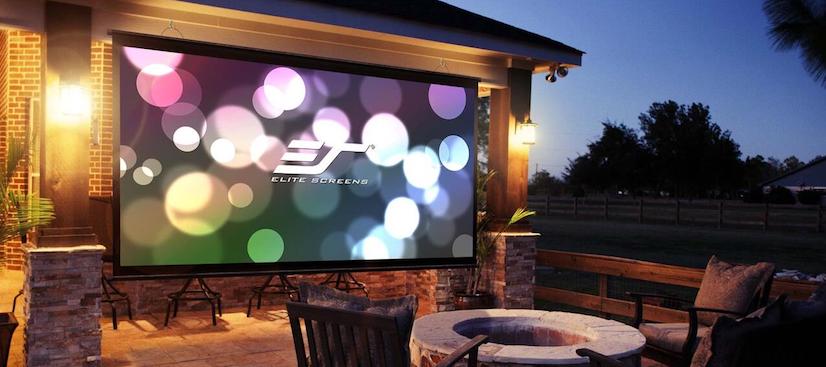
If you’re the type of homeowner who loves family movie nights outside on a deck or patio, then a permanently installed retractable projector screen is the way to go.
With either an exterior manual or a motorized projection screen, you can roll it down to watch a film and roll it up when you’re done.
These roll up display surfaces are made to stay outside in all types of weather, thanks to their weather and insect resistant housing. These exterior retractable screens are tensioned with cable guides and weighted dowels to give you maximum stability even in breezy situations.
They come in a wide range of sizes allowing you to pick the perfect option for alfresco media entertainment on a patio, pool deck, or other outdoor venue.
Inflatable Screens
An inflatable projector screen is one that can be blown up to a significantly large size.
Inflatable outdoor projector screens offer immense size, support, and convenience for your outdoor cinema needs. For a reasonable price, you can get a large blow up projector screen, ready to project on in only a few minutes.
These air filled screens offer great picture quality and are made of a material that could withstand the outdoor elements.
Self inflating screens use fans or air pumps to fill up the frame and stay up. (So don’t worry about blowing one up with your own lung power) The projection display surface is attached to the inflated frame. They come with their own means of support, but depending on the wind on the lawn you may want to use some extra grounding.
Make sure you invest in your blow up screen as the last thing you want is a pinhole prick that makes the setup deflate during the movie. A well made blow up cinema screen is also better at handling windy conditions.
For smaller backyard inflatable screens you should get one that allows you to blow it up before the movie starts, so you don’t have the blower running throughout the movie.
For a larger outdoor experience we’d recommend getting a blowup screen with a continuous air source. This is because on a larger inflatable screen it’s easier for the air to escape so the screen may start to deflate before the movie is finished. While these blowers do make some noise, they’re specially designed to be significantly quieter than you expect. On top of that with a large outdoor theater set up you’ll have significantly more powerful speakers that can easily drown out the noise coming from the blowers.
Foldable Screens

Foldable outdoor projector screens are the perfect option for smaller temporary backyard home theater setups. Simply, unfold the frame; attach the surface material and legs, then project. Simple as that. You can set one up anywhere in your backyard.
A foldable projector screen for your yard is usually made using lightweight aluminum for portability and comes with either a carrying case or bag for easy storage when not in use.
Folding frame projector screens are a great low budget if you don’t plan to make backyard movie nights an everyday thing but you still want outstanding visuals for the film watching outside that you do plan.
Just make sure not to use one of these screens in anything more than a light breeze as they could sail through the air.
Tripod Screens
Similarly to foldable cinema screens, outdoor tripod screens are a great low budget choice for the occasional family movie night. Just set up the tripod and pull down the screen. It’s as easy as that. Backyard tripod screens are also excellent for watching movies in the great outdoors as they’re very portable and easy to take with you camping.
Tripod screens are limited in size compared to other exterior projector screens, so they’re best for smaller gatherings in the yard.
Projector Screen Paint
Last and certainly not least, is to use projector screen paint to make a permanent display surface. While you might think you can just paint a wall white and call it a day, exterior projector screen paint is made to create an ideal surface to project on.
Home projector paints are formulated with titanium oxide and other compounds to produce very sharp, high-resolution pictures.
You can either build a freestanding wall for the purpose of projecting on like a drive-in movie theater, or you can use one of the walls of your house. Some people even paint their garage with outdoor projector screen paint.
One thing to note is that because you won’t be able to make a wall perfectly smooth, an outdoor wall painted with projector screen paint won’t be able to render a true 4K resolution image. The pixels are just too small for a textured surface. So if you want to get the best out of your UHD projector, you’ll need to pair it with a 4k projector screen.
DIY Backyard Projector Screens
Some people choose to make their own DIY outdoor projector screens. If you’re handy this can be a fun, cost effective project.
Though if you choose to go the do it yourself route, unless you build a tensioned screen using reflective fabric that can resolve a 4K, your projected image will be subpar for a high quality movie watching experience.
For the time and material cost to build a DIY backyard projector, you’ll be better off getting a pre-assembled foldable projector screen like the Elite Screens YardMaster
Other Screen Attributes
Because you’ll mostly be watching movies on your projector screen, we’d recommend getting either a 16:9 HDTV or a Cinemascope screen. 16:9 is more likely the size you’d want to go with because most streaming services use this as their standard aspect ratio.
With regards to color, you’ll want to go with a white surface for your exterior screen instead of a grey or black one. While a grey or black projector screen would give you deeper blacks in your image, white screens will reflect an overall brighter image which is more important when watching movies outside.
If you want the best image possible we’d recommend that you get a 4K projector screen or better. These smooth display surfaces offer a much crisper image because they have a textureless surface. If you get a 4K projector, you’ll need a 4K projector screen to fully appreciate the UHD resolution of your projector.
As a general rule of thumb, you’ll want the screen size to be around the same as your projector’s maximum image size, as this will give you a sharp, clear picture.
A Bedsheet Is NOT A Projector Screen
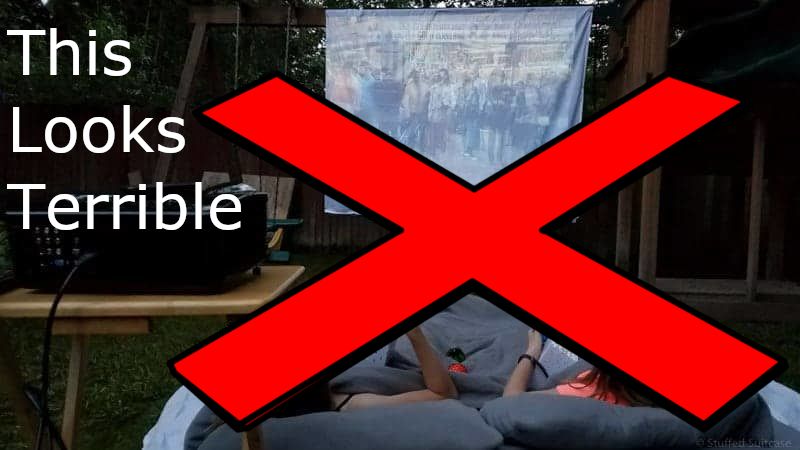
Now you might be thinking, “oh I can just use a bed sheet.” Sure you can do that if you don’t love your family and want them to have a terrible movie watching experience. Bedsheets make for a terrible projection surface for a number of reasons.
- Your image will be distorted because bed sheets by nature have wrinkles, creases and fold lines, even if you iron it beforehand.
- The image colors are going to be off because even a white bedsheet is not truly white enough compared to a real projector screen.
- They’re translucent, so even if you have a projector that’s bright enough to overcome the ambient light around you, a ton of light will pass through the fabric.
- As an outdoor screen even a small bit of wind will cause ripples.
- You’ll look cheap. You paid good money for your projector, you should have a screen to match it.
Outdoor Projectors

Whether inside or outside, the second part of any projection equation is the projector. Once you’ve chosen a projector screen, you can then use the foot lamberts calculator to help you determine if the projector you’re looking at is bright enough. There are many facets that go into buying a projector but to keep this article from being too long we’ll just focus on what to look for specifically in an outdoor movie projector.
For a complete in depth understanding you can read our extensive guide to projectors.
What to look for in a backyard projector?
In theory, with a long enough extension cord, any projector can be an outdoor projector. But that doesn’t mean that any projector will be a “good” backyard projector.
A JVC DLA-NZ7 is an incredible indoor home theater projector, but it lacks the brightness to compete with the ambient light of the great outdoors.
These are the things to look for in an outdoor projector for backyard movies:
- Brightness
- Resolution
- Black levels
- Throw type
- Portability
- Designed to be outdoors
Projector Brightness
Brightness, Brightness, Brightness!
When it comes to a backyard projector, it’s all about the lumens.
You want to choose an exterior projector that is bright enough to project a strong, clear
image that will look just as good outdoors as it would indoors. The larger your screen, the more lumen power you'll need to have at your disposal. If you're working with a relatively small screen that measures 100 inch diagonally, you'll be fine sticking to video projectors that output at least 1600-2000 lumens for night time watching. However, if you're dealing with a jumbo 200 inch projector screen option instead, you'll need between 5400 and 7200 lumens to deliver a quality, theater-grade viewing experience at night.
The earlier you start your movie, the more sun light you'll need to contend with and the more lumens you'll need to overcome that light.
How Many Lumens Should My Outdoor Projector Be?
Screen Size |
Recommended Projector Lumens by Time of Day |
|||
|---|---|---|---|---|
Afternoon* |
Sunset |
Twilight |
Night |
|
100 in |
3000-4000 |
2500-3000 |
2000-2500 |
1600-2000 |
120 in |
4200-5200 |
3100-3500 |
2600-3100 |
2200-2600 |
150 in |
6700-7700 |
4500-5200 |
3700-4200 |
3000-3500 |
200 in |
10800-12000 |
7200-8500 |
6700-7200 |
5400-6000 |
*Daytime projecting is not recommended without talking to a projection expert
Black levels
The black levels are especially important for a backyard projector for a number of reasons. One of the main ones is that you'll be projecting outside on a white cinema screen which can take away some of the contrast of the image. By having better black levels you can compensate for some of this loss.
Projector throw type
You also will need to consider the placement of your projector and screen to determine if you will be using front or rear projection. A front projection setup may be more common but not necessarily more ideal as the audience must be configured around the projector and cannot block its path to the screen. If you decide to go with a rear projection set up, you’ll need to procure a rear projection cinema screen. Many projectors are capable of both forward and rear projection.
You will also need to determine which type of throw to use. A standard throw projector will require you to place the projector much further away from the screen in order to project a large image. Short throw projectors allow you to place the projector much closer to the screen to make a large image, however they often lack any sort of optical zoom. This means that they need to be placed in a fixed position in order to make a certain size image.
There are also Ultra Short Throw projectors which allow you to place the projector extremely close to a screen to produce a large image. UST projectors are great for the outside home theater because they sit directly under the projector screen, so it would be impossible to walk in front of the projector.
Portability
One of the important aspects of an outside projector is its portability. You’ll be moving the device back and forth when you’re not using it so you want to look for one that’s not too heavy or cumbersome. The last thing you want to do is drop your new backyard projector.
Don't simply assume that an outdoor projector capable of projecting high-lumen images is going to be too large and too heavy for comfort. Today's outdoor projectors are not the same as the ones that were standard even ten years ago. Back then, it wasn't uncommon for a 5000 lumen projector to weigh a whopping 90-100 pounds. These days, a projector that is just as powerful or more can weigh in at a mere 20 pounds. Much easier to maneuver and certainly more manageable for home or personal use!
That said, don't let concerns about potential size or weight stop you from investing in a projector with a high enough lumen capacity for your needs.
While you can find battery powered outdoor projectors, they won’t have enough power to display an image larger than maybe 40 inches. They also generally offer very poor image quality.
Outdoor Projector and Screen Tips
Buy for indoor not just outdoor
Instead of buying a projector just for outside, get a projector that you can use indoors as well. By doing this you’ll get the most use out of your investment. Because you’ll be using your device often we recommend spending the extra few bucks and getting a 4K projector.
By getting a unit that can produce a 4K resolution video for outdoors and indoors you guarantee that you’ll be getting the absolute best image quality possible. The first time you watch a film on your 4K projector and screen you’ll know your money was well spent.
Bring your projector for outside inside when when not in use
While there are TVs made for the outdoors, there aren't any projectors designed just to be used outside in all weather. While you can get a projector cage to protect it, you won't want to keep your projector outside, due to weather, excessive heat or cold, and other elements can affect the picture quality or even break your projector.
What direction should I place an outdoor projector screen?

You should place your outdoor projector screen so it's facing either north or south to
avoid as much sunlight as possible around sunset. Ideally you'd want to have the projection surface facing north so the sunlight will be even less direct because of the angle the sun sets.
Build some shade for your exterior projector and screen setup
If you don't have any built-in shaded areas in your backyard, it might make sense to build a structure with some limited cover such as a gazebo. You can also use an awning or popup tent like the ones you see people tailgating under at football games so you have a shaded area to watch a film outside.
Summing It All Up
Watching movies outdoors creates meaningful memories that last a lifetime so get your outdoor projector screen and projector combo today!
If you have any additional questions about using a projector outside don't hesitate to give us a call at (888)392-4814







